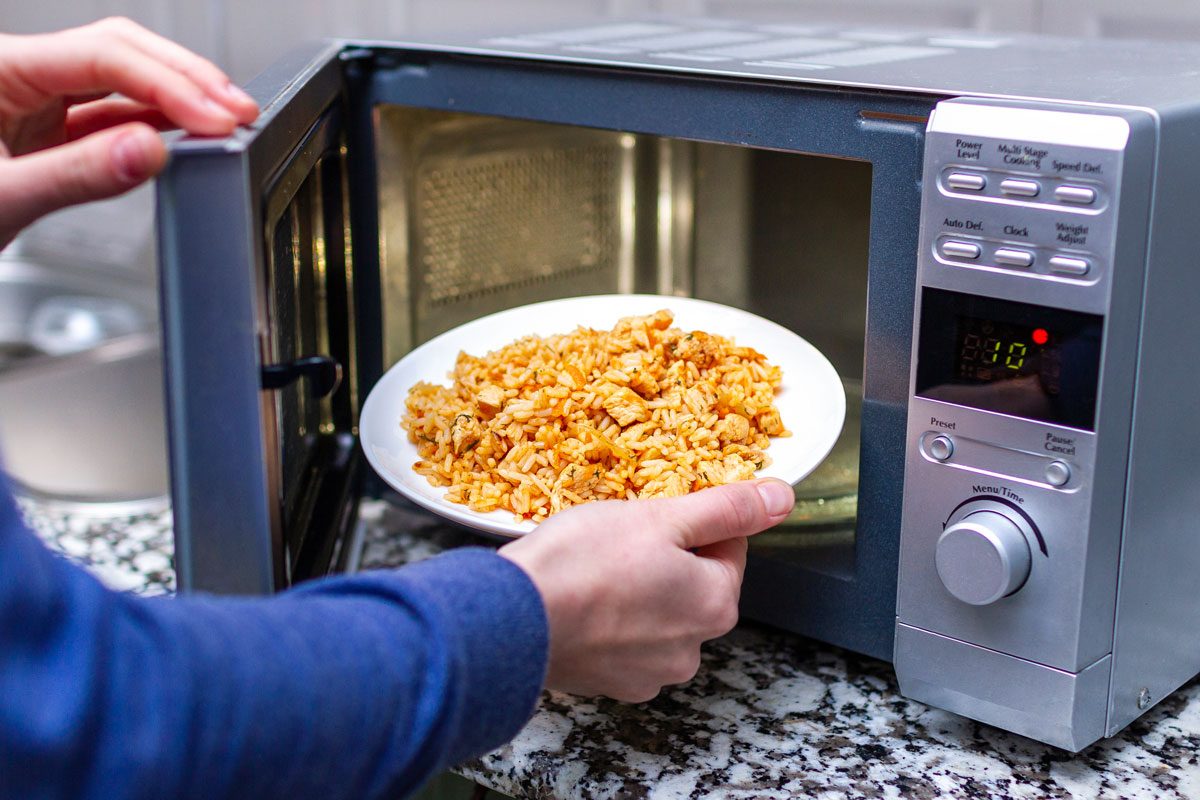If you don't handle and store it properly, leftover rice can make you sick. Here's why—and how to avoid so-called reheated rice syndrome.

What Is Reheated Rice Syndrome—And Just How Dangerous Is It?

Every year, a whopping 1 in 6 Americans gets sick from a foodborne illness. Some of the causes are familiar: salmonella from raw or undercooked meat or poultry, E. coli from contaminated produce and listeria from unpasteurized milk or cheese. But one source of food poisoning may surprise you. It comes from the bacteria Bacillus cereus, and it’s an illness so distinct it has earned the name reheated rice syndrome.
Worried? Don’t be. We consulted food safety experts to find out what causes reheated rice syndrome and how to prevent it. Read on to learn how long rice lasts in the fridge, which other foods can be contaminated with B. cereus—and how to enjoy second-day rice in the safest way possible.
Get Reader’s Digest’s Read Up newsletter for more food tips, humor, cleaning, travel, tech and fun facts all week long.
What is reheated rice syndrome?
In short, reheated rice syndrome (also known as fried rice syndrome or leftover rice syndrome) is food poisoning from B. cereus. The bacteria is commonly present in uncooked rice, though it is usually harmless if the rice is prepared and handled properly.
“B. cereus is a spore-forming bacterium that can survive cooking temperatures and, when left at room temperature for extended periods, can germinate and multiply and produce toxins that cause food poisoning,” says Dana Zhao, MD, a gastroenterologist with Manhattan Gastroenterology who is also affiliated with NewYork-Presbyterian/Weill Cornell Medical Center. “Some of the toxins can withstand cooking temperatures, making it particularly dangerous in reheated rice dishes like fried rice.”
How does reheated rice cause food poisoning?
Unlike illnesses from other common bacteria, the issues with B. cereus come from the spores, explains Keith R. Schneider, PhD, a food safety professor and researcher at the University of Florida. “With spores, what happens is when the bacteria gets into an unfavorable environment [like a pot of boiling water], it goes into defense mode and sheds about 50% of its mass and envelops itself in an endospore. These are very resistant to heat,” he says.
There’s a danger zone between 40 and 140 degrees. “I can cook it, but it’s just going to get mad,” Schneider says. “And as soon as it gets into the ideal temperature zone, it’s going to become active again and start multiplying and become problematic.
Let’s say you heated one of these spores through the cooking process. As it’s cooling, you could run into trouble. “Once it gets below 140 [degrees] and until it gets to 70 [degrees], it will start to germinate and actively grow,” he says. “At that point, if it produces toxins, you can get sick.”
It’s because of this toxin-forming danger zone that this foodborne illness often happens from eating fried rice. It’s not the only culprit: There are a few foods susceptible to the bacteria that you should be aware of (more on those below).
“Fried rice is typically made from leftover rice that sits out and then cooks really quickly in a wok,” says Schneider. “This can mean hours out or back and forth from the fridge.” During this time, the rice can stay in that danger zone for hours, giving the bacteria the opportunity to produce the toxins that can make you sick.
What are the dangers of reheating rice?
If the rice is handled and stored properly during preparation at the restaurant and once you bring it home, it’s as safe to eat as other reheated leftovers. The same goes for rice you make at home. But if you don’t pay attention to proper food storage and handling—that includes not wrapping leftovers in aluminum foil—you set yourself up for potential foodborne illness.
“If you take the takeout box and leave it in your car while you go shopping, then put it in the fridge and eat it a few times, taking it out and putting it back in each time, you can have proliferation [of bacteria],” notes Schneider. And that can lead to some unpleasant symptoms.
There are two main types of illnesses that leftover rice syndrome can cause: the emetic form and the diarrheal form. While these are by far the most common, the bacteria can also lead to other rare but serious sicknesses.
Emetic illness (aka vomiting)

Reheated rice syndrome can cause vomiting when your body notices the bacteria within the first one to six hours of consumption. “Once you consume that rice, your body will immediately realize and vomit it out,” says Schneider.
Diarrheal illness
When it comes to sure signs of food poisoning from B. cereus, diarrhea caused by reheated rice syndrome is common. “You can ingest the microorganism, and if it can survive and set up camp in your GI tract, it can start producing those toxins inside your body,” Schneider says.
At that point, when your body does expel the toxins, they are going to come out the other end. This will typically begin six to 15 hours after you eat the contaminated food and can last for up to 24 hours.
More serious illness
Can reheated rice kill you? Leftover rice syndrome rarely causes more serious illness beyond vomiting and diarrhea. But in very rare cases, if there is enough bacteria present, this form of food poisoning can be deadly. As the Journal of Clinical Microbiology reported, a young man died in 2008 after eating cooked pasta that had been left at room temperature for five days; the pasta contained massive amounts of B. cereus.
Can reheating kill the bacteria in rice?
Unfortunately, no. The spores that B. cereus produces are extremely heat resistant, so no amount of reheating you do at home is going to get rid of them. If your rice has been left out at room temperature for a few hours, or if you’re not sure how long it’s been sitting on the counter, don’t reheat it—toss it in the trash.
How common is reheated rice syndrome?
According to the Centers for Disease Control and Prevention (CDC), there are an estimated 63,400 cases of B. cereus per year in the United States. For comparison, there are about 265,000 E. coli infections every year. The vast majority of B. cereus infections are minor illnesses; of those 63,400 cases, the CDC estimates that B. cereus is responsible for only 20 hospitalizations each year.
What other foods can cause reheated rice syndrome?
While rice is the food most commonly contaminated with high levels of B. cereus, a few other foods can cause leftover rice syndrome. These include other grains, pastas, beans, potatoes and some vegetables. Schneider says to be wary of foods that come from the earth and that we typically cook at a high temperature (using methods such as boiling) and then cool before eating.
Interestingly, one food you don’t need to worry about is sushi, despite the fact that sushi rice is typically kept out at room temperature all day. “With sushi rice, they add rice wine vinegar to reduce the pH of the rice and make it acidic, thus preventing B. cereus from growing,” Schneider explains.
How can you safely reheat rice?
When reheating rice, be sure to cook it to 165 degrees (use a food thermometer to check that the food is sufficiently hot). Place the thermometer sideways through the thickest part of the rice dish. This will help you avoid the dangers of reheated rice.
Are there any other rice-reheating tips? Is it better to cook rice leftovers on the stove or in the microwave? It doesn’t matter how you cook leftover rice, Dr. Zhao says, as long as it was cooled properly when freshly made and reheated to a steaming-hot 165 degrees.
So how do you store cooked rice properly?
Knowing how to cool cooked rice is the key to preventing B. cereus food poisoning, says Brian Labus, PhD, MHP, a professor in the School of Public Health at the University of Nevada, Las Vegas. Since the toxins are super resistant to high temperatures, “cooking isn’t going to destroy them. You need to focus on preventing the problem in the first place by properly cooling rice after cooking it.” Here are steps to prevent leftover rice syndrome.
- Don’t leave leftovers out. “Most leftovers shouldn’t be left out for more than two hours,” says Schneider. “If it’s a really hot day, like a picnic, it’s one hour.” After eating out, bring your doggy bag from the car to the fridge as quickly as possible.
- Refrigerate in shallow containers. This is especially key if you’ve cooked a large pot of rice or ordered enough from the restaurant to serve 10 or more people. “If we put rice in the fridge but not in a shallow container, it’s going to stay warm for hours,” Schneider says. “The fridge is not good at heat removal. The rice can stay warm overnight, so these toxins can potentially build up and germinate.” To avoid this, spread rice or other leftovers in food storage containers that are no deeper than 4 inches to help them cool down and leave the danger zone faster.
- When in doubt, throw it out. If you’re not sure how long a container of food has been sitting out on the counter and it contains rice or one of the other risky foods mentioned above, it’s best to throw it away. This is especially true for people who have a compromised immune system, such as older adults and pregnant people. When it comes to food safety, it’s always smart to play it safe.
About the experts
|
Why trust us
At Reader’s Digest, we’re committed to producing high-quality content by writers with expertise and experience in their field in consultation with relevant, qualified experts. We rely on reputable primary sources, including government and professional organizations and academic institutions as well as our writers’ personal experiences where appropriate. For this piece on reheated rice syndrome, Alyssa Sybertz tapped her experience as a longtime food journalist and the author of The OMAD Diet. We verify all facts and data, back them with credible sourcing and revisit them over time to ensure they remain accurate and up to date. Read more about our team, our contributors and our editorial policies.
Sources:
- Dana Zhao, MD, a gastroenterologist with Manhattan Gastroenterology; interviewed, March 2025
- Brian Labus, PhD, MPH, assistant professor and researcher in the School of Public Health at the University of Nevada, Las Vegas; interviewed, March 2025
- Keith R. Schneider, PhD, food safety professor and researcher at the University of Florida; interviewed, October 2023
- National Library of Medicine: “Bacillus Cereus”
- Centers for Disease Control and Prevention: “Four Steps to Food Safety”
- University of Florida IFAS Extension: “Preventing Foodborne Illness: Bacillus cereus“
- Morbidity and Mortality Weekly Report: “Bacillus cereus food poisoning associated with fried rice at two child day care centers — Virginia 1993″
- Journal of Clinical Microbiology: “Sudden death of a young adult associated with Bacillus cereus food poisoning”
- USDA: “Food Thermometers”























